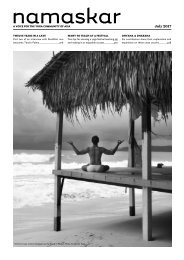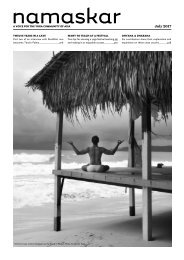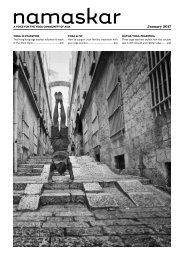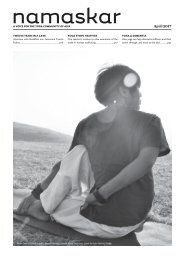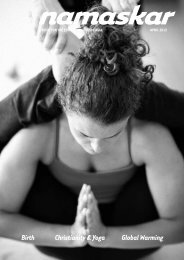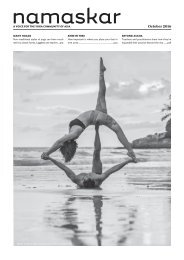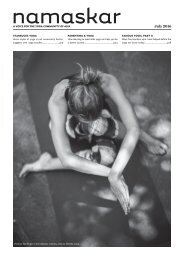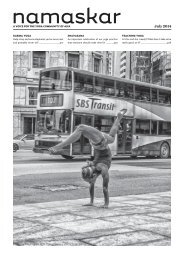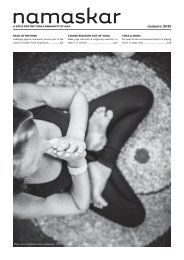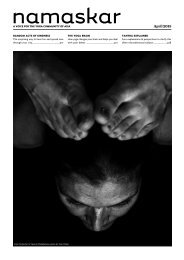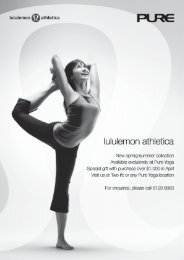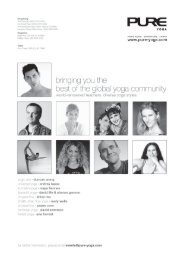Namaskar July 2010
Create successful ePaper yourself
Turn your PDF publications into a flip-book with our unique Google optimized e-Paper software.
Teacher’s Voice<br />
George Dovas<br />
break down the deeper<br />
philosophical concepts into<br />
something we can relate to, our<br />
students will find greater meaning<br />
STEP 4: SEQUENCE<br />
When we are bringing philosophy into our yoga classes, we should<br />
have sequences that can be connected to the philosophy we are<br />
trying to present. If our theme is the celebration of our innate<br />
freedom, and the joy of embodiment, it may be a good idea to do<br />
something dynamic. Strong vinyasa, backbends, arm balances all<br />
may have deeply celebratory themes. In the same way if we are<br />
moving into forward bends, we can talk about the benefits of<br />
becoming quiet, or perhaps we could talk about the quality of tapas,<br />
and how it takes real strength to hold poses with integrity for a<br />
long time.<br />
STEP 5: INTERWEAVE<br />
In my Anusara training, we often talk about the spiritual sandwich.<br />
As you may imagine the spiritual sandwich is full of yoga poses in<br />
the middle, with a little spiritual filling in the beginning and at the<br />
end. While this is a great way to begin bringing a deeper meaning<br />
into our yoga practice, it can often leave the students feeling a<br />
separation between the work in our bodies, and the philosophy the<br />
teacher is trying to present. It may take a long time to get really<br />
good at this, but there are a lot of ways that it can be practiced, like<br />
looking at the clock and every 20-30 minutes bring up the theme<br />
again. Another way may be to take specific poses that embody the<br />
theme, and remind the students when it is time to teach those<br />
poses.<br />
STEP 6: PRACTICE, PRACTICE, PRACTICE<br />
When we as yoga teachers are trying to bring more depth into our<br />
teachings, we must try all sorts of different ways. As yoga teachers<br />
we are here to inspire, to create and to embody a deeper sense of<br />
freedom and joy. John Friend explains the three most important<br />
qualities of being a teacher as: soft heart, sharp mind, and vibrant<br />
body. When we are trying to deepen our philosophical<br />
foundations as teachers, we use these three qualities to be the best<br />
teachers we can be. Teaching with sensitivity, compassion,<br />
intelligence, strength, and coordination, infused with philosophy<br />
to present some amazing yoga classes to all those<br />
who are fortunate enough to cross our paths.<br />
WHAT IS YOUR MOST CHALLENGING ASANA AND WHY?<br />
All asanas are challenging in one way or another.<br />
Along the path of practice, various asanas have challenged me -<br />
physically and mentally. As my practice has developed, my “most<br />
challenging” asana has changed. As my body has changed, the<br />
“most challenging” asana has changed. As circumstances in my life<br />
have changed, my “most challenging” asana has changed.<br />
One of my current “most challenging” asanas is Kurmasana. My<br />
body does not want to hold that pose - my mind wavers and it’s<br />
challenging to find stillness in the pose.<br />
WHAT HAVE YOU LEARNED FROM THIS ASANA?<br />
This was a pose that I once used to do with relative ease. This has<br />
taught me that the body is always undergoing physical changes and<br />
what once appeared “easy”, may appear “challenging” tomorrow. It<br />
has taught me not to think of poses too much in the context of<br />
“easy/challenging” and instead to learn the lesson that is for me<br />
from each of the asanas.<br />
WHAT IS THE MOST CHALLENGING ASPECT OF YOUR PRACTICE?<br />
To still the fluctuations of the consciousness - some days they are<br />
like a raging river!<br />
Born in Sydney, George Dovas is an Iyengar yoga teacher who has<br />
been living in Hong Kong for 10 years. He recently become the<br />
owner and Director of the Iyengar Yoga Centre of Hong Kong. He<br />
teaches asana classes and conducts discussions about yoga<br />
philosophy in the Yoga Sutras. george@iyengaryogahongkong.com<br />
22<br />
Benjamin is 34 years old, and for more than<br />
three years has being teaching Anusara yoga at<br />
The Orange Room and Yoga Space in Shanghai,<br />
China. His inspiration comes from amazing<br />
students, the sun that always shines, and his<br />
teacher John Friend.<br />
benjaminfinnerty@gmail.com



